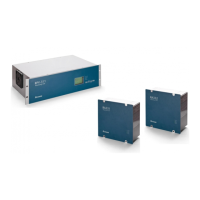Chapter 15 – Installation
Each link on the RPV311, composed of a pair of fiber-optic connectors, is named from A to H. For each link,
an optical fibers pair is used to make transmission and reception of data between the processing module and
the acquisition modules. Connections with acquisition modules must be made according to the sequence of
RPV311 identification: the first connection should be made with link A, the second, with link B, and so forth.
On the RPV311, each link has an ACT indicator, as shown in Figure 109, which lights up when the link is
receiving data of the acquisition module.
Figure 109: RPV311 Fiber Optic Connectors
The RA331 and RA332 modules each occupy one physical link of the processing module. The RA333
occupies two physical links of the processing module, one for data transmission of analog channels (DFR)
and the other for data transmission of TW channels (TW).
On the RA331, RA332 and RA333 (TW and DFR) modules, each link has an indicator showing the state of
the connection with the processing module, as shown in Figure 110. These indicators, LINK and ACT, on the
front panel and back panel, respectively, light up when the link is active (i.e. it is receiving requests of the
processing module).
Figure 110: RA331, RA332 and RA333 fiber optic connectors
The connectors are identified as RX for receiving data and TX for transmitting data. The corresponding fibers
must be linked to the acquisition module so that the TX of RPV311 is connected to the RX of the RA331,
RA332, or RA333 and RX of RPV311 is connected to the TX of the RA331, RA332, or RA333, according to
Figure 111.

